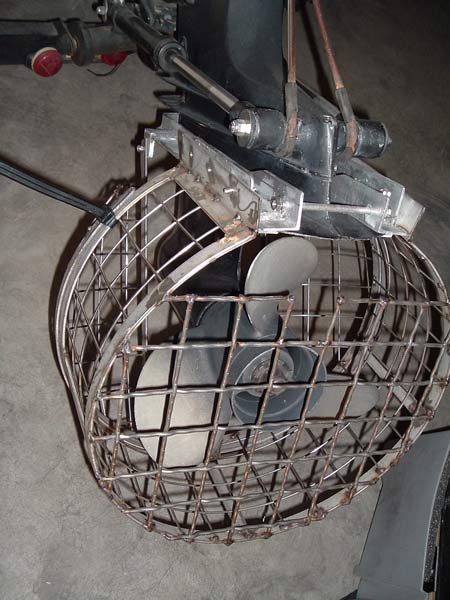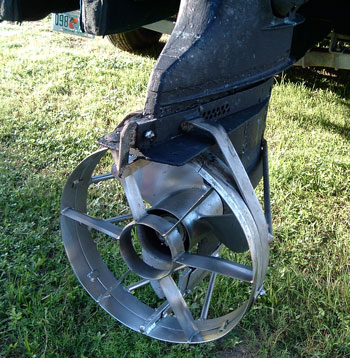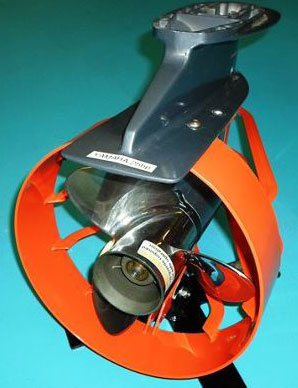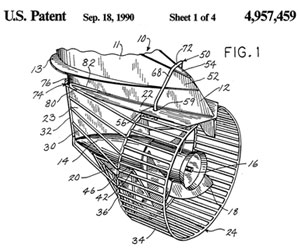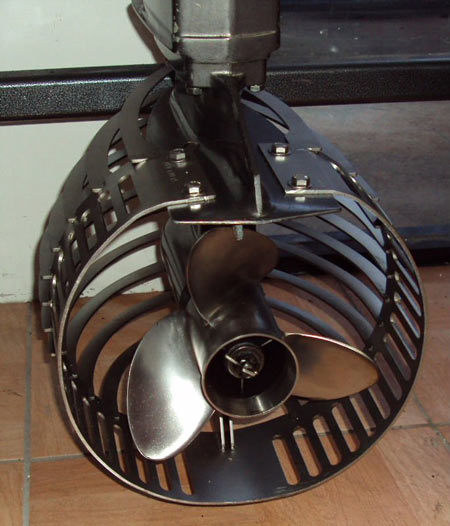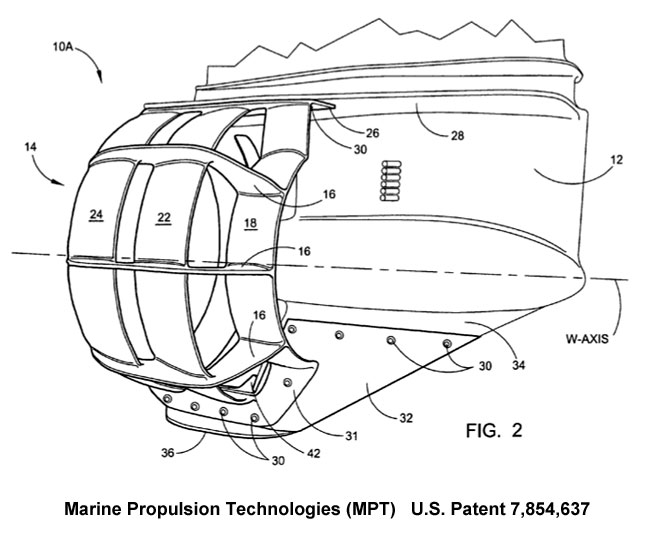Propeller guards, especially cage type propeller guards, are designed by navigating a series of trade offs. When some designers first enter the area, they think about designing a propeller guard that will work for all boats in all situations. After a while they realize they need to narrow their scope and begin to made trade offs based upon the:
- Type of boats targeted (top speeds)
- Primary uses of those boats (fishing, towed sports, cruising, partying, rentals, rescue, etc.)
- Environment the boats are used in (shallow water, weeds)
- Anticipated production volumes
- Cost targets
Note, several statements made in this post are generalities. There are specific exceptions to many of them.
The Trade Offs
Selecting which areas of the propeller to guard (front, side, and / or rear) is the first tradeoff. Designers typically immediately choose to totally surround the propeller with some sort of screen, mesh, or cage. However, once they build one, they learn how much drag it creates and begin to limit protection from certain directions to improve boat performance.
Mesh size is the second trade off. The designer selects a mesh size to achieve the proper balance between protection, boat performance, drag, potential for entrapment, and cavitation. Those variables are tightly tied to mesh size.
Generally, the tighter the mesh:
- The better protection the guard provides
- The less opportunity for entrapment the guard provides
- The greater the drag, emissions, and fuel consumption
- The worse the boat performs (top end speed, acceleration, time to plane)
- The more likely the guard is to create cavitation issues
- The more likely weeds or debris entrapment will become an issue
Some of those variables reach a minimum, a cap, or an asymptote some where in the range of 1/2 inch mesh to 4 inch mesh.
For example,
A 1/2 inch mesh generally:
- Provides excellent protection
- Minimizes entrapment of body limbs
- Creates significant drag which negatively influences boat performance and increases fuel consumption
- Can create cavitation issues
- Maximizes weed and debris entrapment issues
While on the other side of the range, a 4 inch mesh generally:
- Provides minimal protection for fingers, small hands, toes, small feet, or children’s limbs
- Provides significant potential for entrapment of human limbs
- Minimally impacts boat performance
- Minimizes cavitation issues
- Minimally increases fuel consumption
- Has fewer issues with weeds and debris
- Provides core body and head protection at slower speeds while sacrificing protection of the extremities
The terms “mesh” and “screen” in this post refer not only to typical square grid screens, but also to to non-square grids, to varying grids, to long narrow slots created by vanes, and to gaps in propeller guard cages created from rods.
Wire or rod size is tightly tied to mesh size. The more open the mesh or screen, the larger the wires / rods need to be in order to provide the equivalent strength and rigidity.
Material selection is another trade off. Stainless steel allows the use of smaller diameter rods or wires (reduces drag) while increasing corrosion protection, but significantly increases cost. Aluminum is lighter and little more repairable after a crash, but can have corrosion problems. Either material, near a propeller will need to be watched for corrosion issues.
Plastics have low production costs, can be molded in complex shapes, and minimize corrosion issues. However, high tooling costs, possible durability issues, and public perception tend to limit their use in propeller guard construction. However, one of the more widely used guards is made of polypropylene / plastic. We suspect that is driven by price point and availability. Plastic guards generally sell for less that comparable sized metal guards and are available from many outlets.
One of the early ring type guards built for protecting people was said to have been made from PVC pipe (Chadwell guard).
Carbon fiber may be on the wish list, but it is not among the available choices at the moment.
Wire, rod, and strut cross sectional shapes are another tradeoff. Elliptical or Vane shaped rods can be used to reduce drag (side with minimum thickness is against the direction of flow). Similarly some guards use a series of concentric ring vanes (looks like a bullseye target from the rear). While vane shaped protectors minimize drag, their large flat surfaces can create boat handling issues in some situations. Concentric ring vanes are said to improve handling at slower speeds, increase thrust, and slightly increase top speeds in some situations.
Mounting methods are another trade off. Outboards and stern drives present have been built by many manufactures, each with their own designs, models, and frame sizes (a few horsepower sizes built on the same frame). This creates problems for designers trying to mount their propeller guard to the drive, and often requires a series of different mounting kits.
Some manufacturers (see the Propeller Solutions guard photo below) choose to just drill some holes and screw their guard on somewhere, typically to the anticavitation plate and sometimes also to the skeg. Drive manufacturers generally do not like you drilling holes in their product. They may blame failures under warranty on your alteration of their product by drilling holes in it and adding a guard.
Others (see the MariTech houseboat propeller guard image below) choose to use some sort of harness that “grabs” the drive, typically above the anticavitation plate.
Still others (see the Snyder guard patent drawing below) try to sandwich the drive by snugly fitting the leading vertical edge of the drive and pulling the guard back and up against something wrapped above the anticavitation plate (Snyder guard).
Mounting methods selected can dictate whether or not the guard can be installed when the boat is in the water.
Whatever mounting method drive designers choose, they need to be careful not to interfere the water intakes or the speedometer pickup. Its also nice if the drive can still be flushed with earmuffs or a hose connection.
Which models to offer becomes a major decision. As mentioned earlier, each drive manufacturer has their own drive designs and models based on some limited number of drive frame sizes, however most drive manufacturers also have legacy drives they no longer manufacture. Some of those legacy drives are a substantial percentage of the drives still in service. Some major manufacturers of marine drives, such as Outboard Marine Corporation (OMC), are not longer in business.
When you matrix all the manufacturers including legacy drives and legacy manufacturers against the range of propeller sizes, all of a sudden things get really ugly. Propeller guard manufacturers may have to create dozens of versions just to cover some of the more popular models. Each version they add creates more tooling costs, setup costs, inventory costs, distribution costs, and makes it more likely they or their distributors will not have the correct version in stock when a potential customer comes calling.
The more models they offer the greater their potential sales, but also the greater their costs.
Rigidity vs. Crushability of the guard determines how much force it will transmit through its mounting structure to the drive when striking underwater obstacles (bottom of the lake, sunken logs, rock outcroppings). Very strong and rigid prop guards transmit the entire load to the drive, possibly creating failures at their mounting points. More crushable, deformable guards absorb some of those loads, but might be crushed into the propeller. If a metal guard is crushed into the propeller it can damage the propeller, render the boat inoperable, and possible damage the innards of the drive itself.
Coatings or Platings are another choice. The guard can be made more corrosion resistant, brighter, and prettier, but for a price.
Flapping up or retracting all or portions of the guard when underway can minimize drag. However, it can add complexity and cost to the guard while making it less rigid if designers are not careful.
Serviceability is yet another trade off. Designers want to make it easy for boaters to access the propeller, to access service points of the drive, and to repair the guard if necessary. But access panels, and replaceable sections create joints in the guard structure which can lead to weaknesses. If designers leave access to the propeller open from the rear, people swimming behind the vessel or at the swim ladder are less protected if the engine is started and placed in gear (especially if it is placed in reverse) plus the potential for entrapment of those behind the vessel or at the swim ladder is increased.
Weave of the Wire or Attachment Methods of the Rods are trade offs most designers don’t even know they are making. Different ways of making or forming the joints between crossing wires or rods can influence drag.
How close to put the guard to the propeller is another decision for designers. Just clearing the prop blade tips minimizes the increased cross sectional area that could strike those in the water vs. an open propeller, but it also increases the likelihood the guard could be crushed into the propeller. Putting the rear screen close to the propeller shortens the assembly, but makes it easier for fingers and toes to get closer to the propeller. Placing the guard very close to the propeller also increases the probability of cavitation and corrosion issues.
Many products involve trade offs in design, however propeller guards, and especially cage type propeller guards require designers to make a number of interrelated choices.
We will now illustrate some of the choices previously made by propeller guard designers.
Some Examples of Propeller Guards and Their Design Tradeoffs
Most U.S. constructed propeller guard screens are made from a wire mesh constructed of round wires formed or welded into a grid/mesh.For example, the rear screen of MariTech’s SwimGuard propeller guard is cut from a wire mesh in which the wires have a circular cross section. This photo is from a MariTech installation demonstration at their factory with some parts before they were painted. The MariTech SwimGuard works great on displacement boats like houseboats and most pontoon boats. However, on planing boats at faster speeds, the guard creates considerable drag. As a result, MariTech also produces a version that is more open to the front and rear often used on rescue boats called the Swim Guard Pro. They state the guard provides “core” protection (meaning the core of your body) and recognize hands and feet may enter the propeller area. They provide the more open version in an effort to provide a balance of protection and top end speed for faster boats.
| Robert Hooper’s Prop Buddy propeller guard used a series of approximately 5/16 inch diameter rods with a circular cross section to form a barrier around the propeller. His more open design creates less drag than mesh type guards and was used on many planing boats, including some capable of achieving speeds in excess of 60 miles per hour. |
|
Propeller Solutions Prop Deflector combines a series of vanes with a ring guard. They bolt it to the anticavitation plate and to the bottom of the skeg. Propeller Solutions’ selection of propeller design variables produced a guard with protection to the front and sides with minimal drag. |
| Richard “Dick” Snyder of Mercury Marine invented a somewhat similar propeller guard composed of rods as seen at left. |
Jiaxing Dajiang Mould Co. Ltd. of China currently offers several “vane” type propeller guards on Alibaba.com similar to those being used in Australia. The wide, flat “vanes” are rounded on the front and rear edges creating a flattened elliptical cross section.
Marine Propulsion Technologies (MPT) Thrustor is being sold as a thrust enhancer and to improve handling at slow speeds, but is also seen as a propeller guard. Composed of a series of metal concentric rings (vanes) it is somewhat of a heavy duty, big brother to the polypropylene Prop Guard available from propguard.net.In Closing
As can be seen by the examples above, many designers have different approaches, different target markets, and different views of how to approach the problem.
We created this page to provide some background information for future propeller guard designers, and especially for some student researchers we are trying to encourage to create some tools to help guard designers make more informed decisions as they navigate the many propeller guard design trade offs.
Currently, it is almost as if each of the trade offs above has a slider associated with it and designers fiddle with those sliders to control the final design. But many propeller guard designers don’t understand some of those sliders are nonlinear controls and/or influence multiple outputs. As a result, propeller guard designers end up with suboptimal designs. We hope, with the help of some student researchers, to change that in the future.
